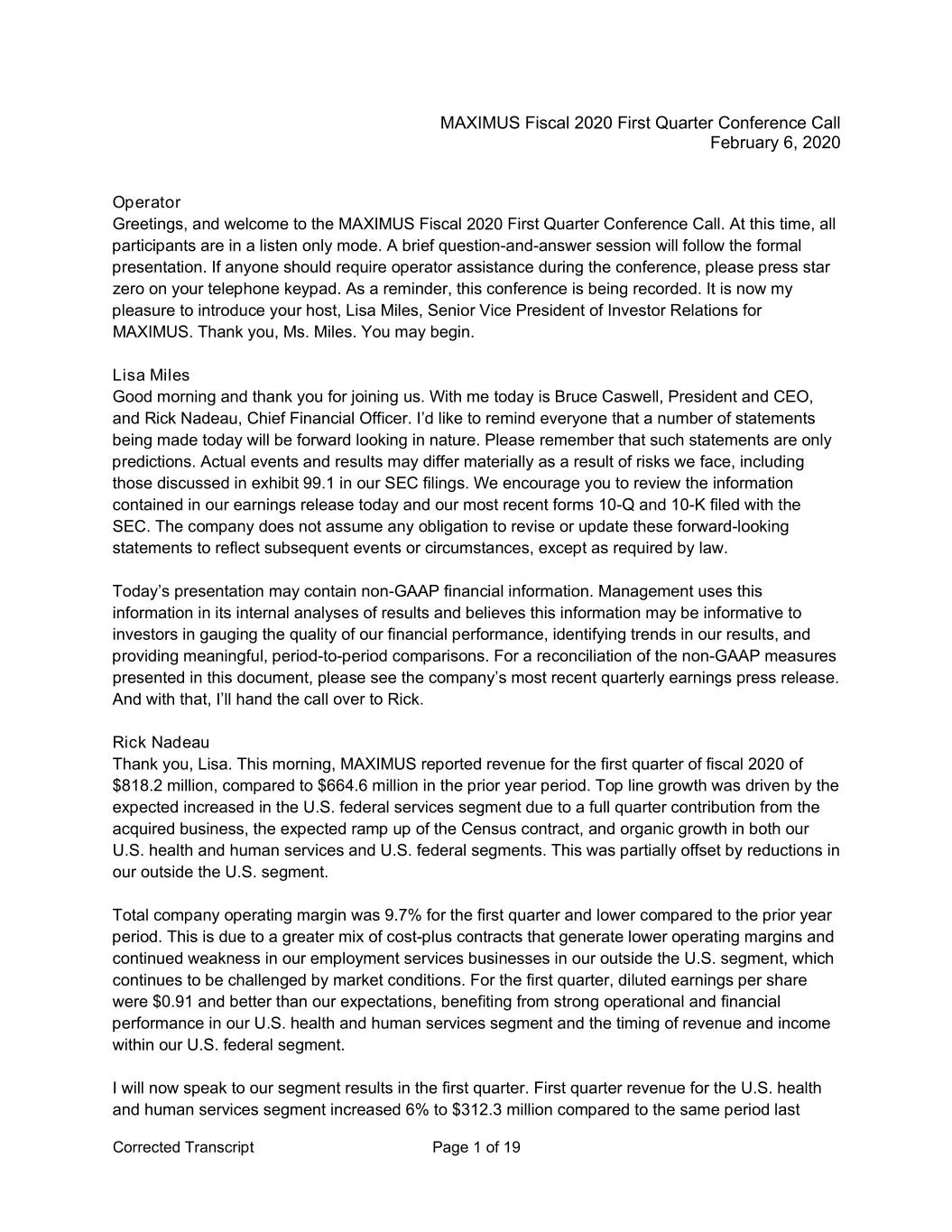
MAXIMUS Fiscal 2020 First Quarter Conference Call February 6, 2020 Operator Greetings, and welcome to the MAXIMUS Fiscal 2020 First Quarter Conference Call. At this time, all participants are in a listen only mode. A brief question-and-answer session will follow the formal presentation. If anyone should require operator assistance during the conference, please press star zero on your telephone keypad. As a reminder, this conference is being recorded. It is now my pleasure to introduce your host, Lisa Miles, Senior Vice President of Investor Relations for MAXIMUS. Thank you, Ms. Miles. You may begin. Lisa Miles Good morning and thank you for joining us. With me today is Bruce Caswell, President and CEO, and Rick Nadeau, Chief Financial Officer. I’d like to remind everyone that a number of statements being made today will be forward looking in nature. Please remember that such statements are only predictions. Actual events and results may differ materially as a result of risks we face, including those discussed in exhibit 99.1 in our SEC filings. We encourage you to review the information contained in our earnings release today and our most recent forms 10-Q and 10-K filed with the SEC. The company does not assume any obligation to revise or update these forward-looking statements to reflect subsequent events or circumstances, except as required by law. Today’s presentation may contain non-GAAP financial information. Management uses this information in its internal analyses of results and believes this information may be informative to investors in gauging the quality of our financial performance, identifying trends in our results, and providing meaningful, period-to-period comparisons. For a reconciliation of the non-GAAP measures presented in this document, please see the company’s most recent quarterly earnings press release. And with that, I’ll hand the call over to Rick. Rick Nadeau Thank you, Lisa. This morning, MAXIMUS reported revenue for the first quarter of fiscal 2020 of $818.2 million, compared to $664.6 million in the prior year period. Top line growth was driven by the expected increased in the U.S. federal services segment due to a full quarter contribution from the acquired business, the expected ramp up of the Census contract, and organic growth in both our U.S. health and human services and U.S. federal segments. This was partially offset by reductions in our outside the U.S. segment. Total company operating margin was 9.7% for the first quarter and lower compared to the prior year period. This is due to a greater mix of cost-plus contracts that generate lower operating margins and continued weakness in our employment services businesses in our outside the U.S. segment, which continues to be challenged by market conditions. For the first quarter, diluted earnings per share were $0.91 and better than our expectations, benefiting from strong operational and financial performance in our U.S. health and human services segment and the timing of revenue and income within our U.S. federal segment. I will now speak to our segment results in the first quarter. First quarter revenue for the U.S. health and human services segment increased 6% to $312.3 million compared to the same period last Corrected Transcript Page 1 of 19
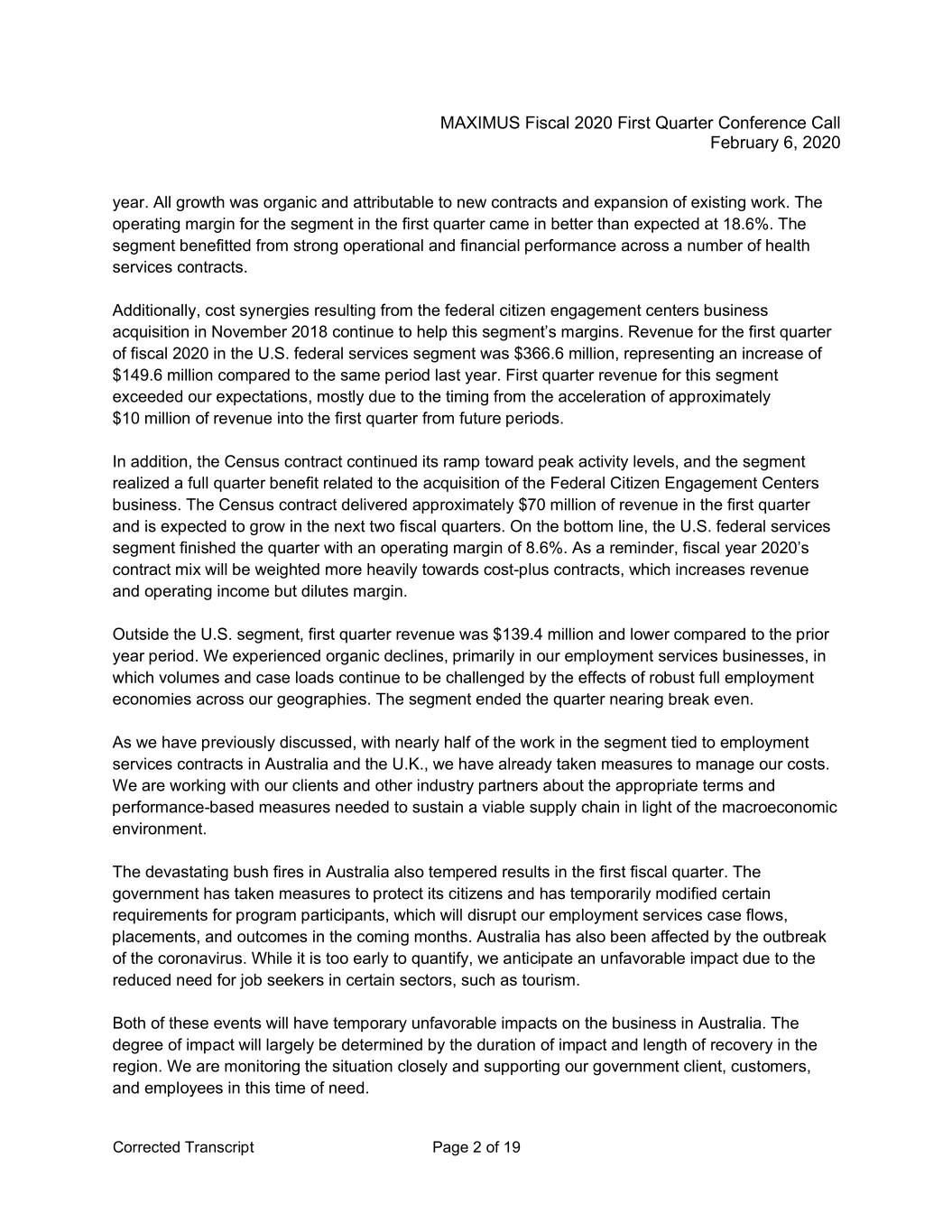
MAXIMUS Fiscal 2020 First Quarter Conference Call February 6, 2020 year. All growth was organic and attributable to new contracts and expansion of existing work. The operating margin for the segment in the first quarter came in better than expected at 18.6%. The segment benefitted from strong operational and financial performance across a number of health services contracts. Additionally, cost synergies resulting from the federal citizen engagement centers business acquisition in November 2018 continue to help this segment’s margins. Revenue for the first quarter of fiscal 2020 in the U.S. federal services segment was $366.6 million, representing an increase of $149.6 million compared to the same period last year. First quarter revenue for this segment exceeded our expectations, mostly due to the timing from the acceleration of approximately $10 million of revenue into the first quarter from future periods. In addition, the Census contract continued its ramp toward peak activity levels, and the segment realized a full quarter benefit related to the acquisition of the Federal Citizen Engagement Centers business. The Census contract delivered approximately $70 million of revenue in the first quarter and is expected to grow in the next two fiscal quarters. On the bottom line, the U.S. federal services segment finished the quarter with an operating margin of 8.6%. As a reminder, fiscal year 2020’s contract mix will be weighted more heavily towards cost-plus contracts, which increases revenue and operating income but dilutes margin. Outside the U.S. segment, first quarter revenue was $139.4 million and lower compared to the prior year period. We experienced organic declines, primarily in our employment services businesses, in which volumes and case loads continue to be challenged by the effects of robust full employment economies across our geographies. The segment ended the quarter nearing break even. As we have previously discussed, with nearly half of the work in the segment tied to employment services contracts in Australia and the U.K., we have already taken measures to manage our costs. We are working with our clients and other industry partners about the appropriate terms and performance-based measures needed to sustain a viable supply chain in light of the macroeconomic environment. The devastating bush fires in Australia also tempered results in the first fiscal quarter. The government has taken measures to protect its citizens and has temporarily modified certain requirements for program participants, which will disrupt our employment services case flows, placements, and outcomes in the coming months. Australia has also been affected by the outbreak of the coronavirus. While it is too early to quantify, we anticipate an unfavorable impact due to the reduced need for job seekers in certain sectors, such as tourism. Both of these events will have temporary unfavorable impacts on the business in Australia. The degree of impact will largely be determined by the duration of impact and length of recovery in the region. We are monitoring the situation closely and supporting our government client, customers, and employees in this time of need. Corrected Transcript Page 2 of 19
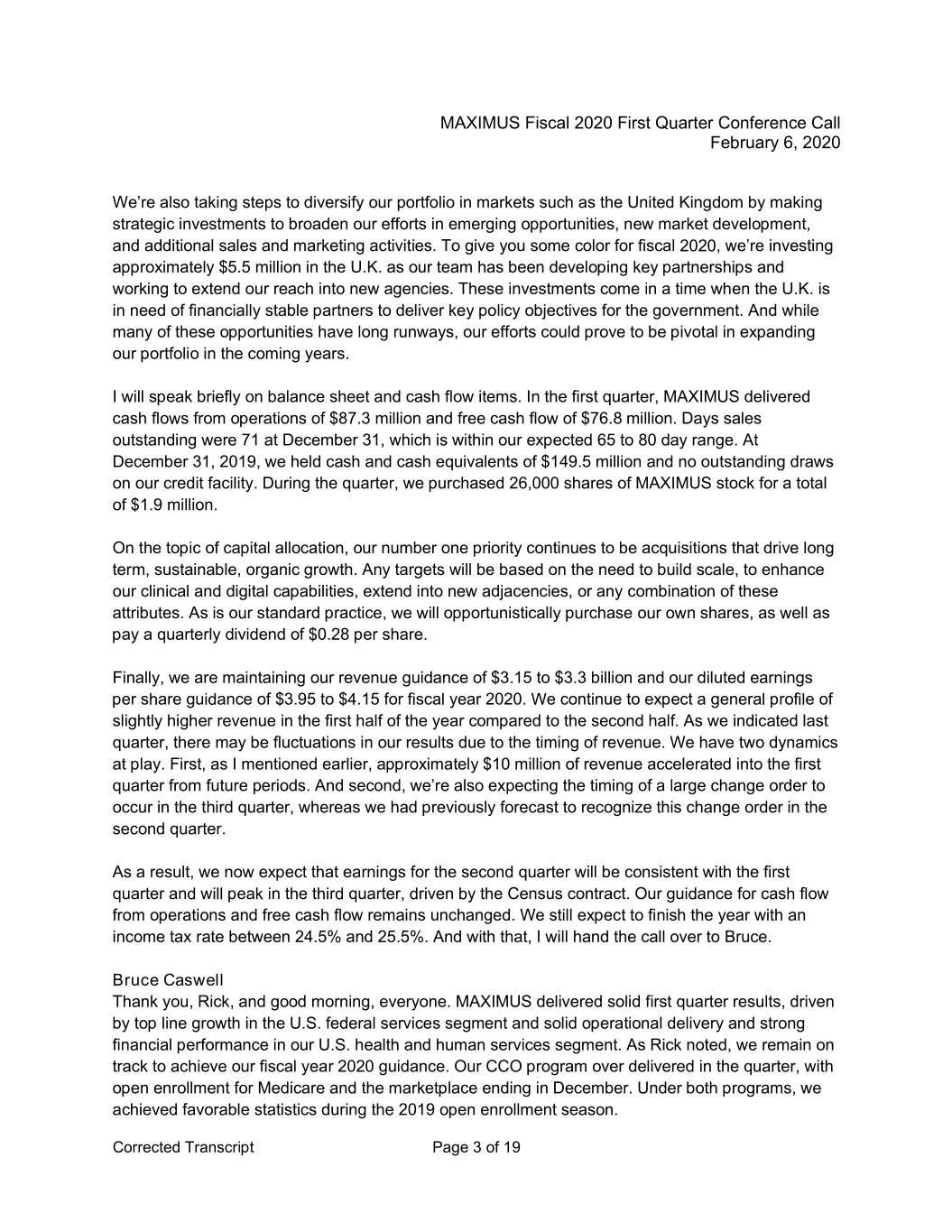
MAXIMUS Fiscal 2020 First Quarter Conference Call February 6, 2020 We’re also taking steps to diversify our portfolio in markets such as the United Kingdom by making strategic investments to broaden our efforts in emerging opportunities, new market development, and additional sales and marketing activities. To give you some color for fiscal 2020, we’re investing approximately $5.5 million in the U.K. as our team has been developing key partnerships and working to extend our reach into new agencies. These investments come in a time when the U.K. is in need of financially stable partners to deliver key policy objectives for the government. And while many of these opportunities have long runways, our efforts could prove to be pivotal in expanding our portfolio in the coming years. I will speak briefly on balance sheet and cash flow items. In the first quarter, MAXIMUS delivered cash flows from operations of $87.3 million and free cash flow of $76.8 million. Days sales outstanding were 71 at December 31, which is within our expected 65 to 80 day range. At December 31, 2019, we held cash and cash equivalents of $149.5 million and no outstanding draws on our credit facility. During the quarter, we purchased 26,000 shares of MAXIMUS stock for a total of $1.9 million. On the topic of capital allocation, our number one priority continues to be acquisitions that drive long term, sustainable, organic growth. Any targets will be based on the need to build scale, to enhance our clinical and digital capabilities, extend into new adjacencies, or any combination of these attributes. As is our standard practice, we will opportunistically purchase our own shares, as well as pay a quarterly dividend of $0.28 per share. Finally, we are maintaining our revenue guidance of $3.15 to $3.3 billion and our diluted earnings per share guidance of $3.95 to $4.15 for fiscal year 2020. We continue to expect a general profile of slightly higher revenue in the first half of the year compared to the second half. As we indicated last quarter, there may be fluctuations in our results due to the timing of revenue. We have two dynamics at play. First, as I mentioned earlier, approximately $10 million of revenue accelerated into the first quarter from future periods. And second, we’re also expecting the timing of a large change order to occur in the third quarter, whereas we had previously forecast to recognize this change order in the second quarter. As a result, we now expect that earnings for the second quarter will be consistent with the first quarter and will peak in the third quarter, driven by the Census contract. Our guidance for cash flow from operations and free cash flow remains unchanged. We still expect to finish the year with an income tax rate between 24.5% and 25.5%. And with that, I will hand the call over to Bruce. Bruce Caswell Thank you, Rick, and good morning, everyone. MAXIMUS delivered solid first quarter results, driven by top line growth in the U.S. federal services segment and solid operational delivery and strong financial performance in our U.S. health and human services segment. As Rick noted, we remain on track to achieve our fiscal year 2020 guidance. Our CCO program over delivered in the quarter, with open enrollment for Medicare and the marketplace ending in December. Under both programs, we achieved favorable statistics during the 2019 open enrollment season. Corrected Transcript Page 3 of 19
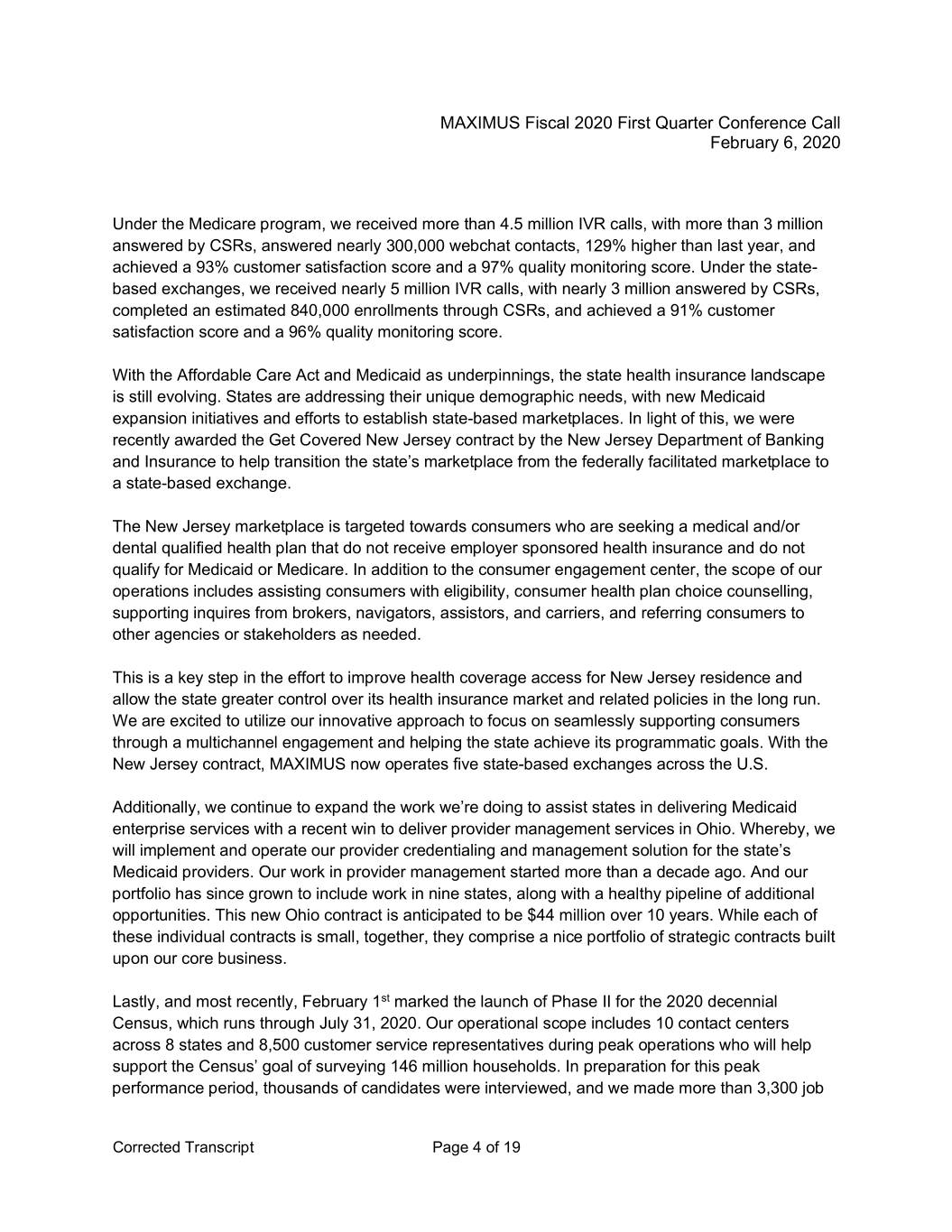
MAXIMUS Fiscal 2020 First Quarter Conference Call February 6, 2020 Under the Medicare program, we received more than 4.5 million IVR calls, with more than 3 million answered by CSRs, answered nearly 300,000 webchat contacts, 129% higher than last year, and achieved a 93% customer satisfaction score and a 97% quality monitoring score. Under the state- based exchanges, we received nearly 5 million IVR calls, with nearly 3 million answered by CSRs, completed an estimated 840,000 enrollments through CSRs, and achieved a 91% customer satisfaction score and a 96% quality monitoring score. With the Affordable Care Act and Medicaid as underpinnings, the state health insurance landscape is still evolving. States are addressing their unique demographic needs, with new Medicaid expansion initiatives and efforts to establish state-based marketplaces. In light of this, we were recently awarded the Get Covered New Jersey contract by the New Jersey Department of Banking and Insurance to help transition the state’s marketplace from the federally facilitated marketplace to a state-based exchange. The New Jersey marketplace is targeted towards consumers who are seeking a medical and/or dental qualified health plan that do not receive employer sponsored health insurance and do not qualify for Medicaid or Medicare. In addition to the consumer engagement center, the scope of our operations includes assisting consumers with eligibility, consumer health plan choice counselling, supporting inquires from brokers, navigators, assistors, and carriers, and referring consumers to other agencies or stakeholders as needed. This is a key step in the effort to improve health coverage access for New Jersey residence and allow the state greater control over its health insurance market and related policies in the long run. We are excited to utilize our innovative approach to focus on seamlessly supporting consumers through a multichannel engagement and helping the state achieve its programmatic goals. With the New Jersey contract, MAXIMUS now operates five state-based exchanges across the U.S. Additionally, we continue to expand the work we’re doing to assist states in delivering Medicaid enterprise services with a recent win to deliver provider management services in Ohio. Whereby, we will implement and operate our provider credentialing and management solution for the state’s Medicaid providers. Our work in provider management started more than a decade ago. And our portfolio has since grown to include work in nine states, along with a healthy pipeline of additional opportunities. This new Ohio contract is anticipated to be $44 million over 10 years. While each of these individual contracts is small, together, they comprise a nice portfolio of strategic contracts built upon our core business. Lastly, and most recently, February 1st marked the launch of Phase II for the 2020 decennial Census, which runs through July 31, 2020. Our operational scope includes 10 contact centers across 8 states and 8,500 customer service representatives during peak operations who will help support the Census’ goal of surveying 146 million households. In preparation for this peak performance period, thousands of candidates were interviewed, and we made more than 3,300 job Corrected Transcript Page 4 of 19
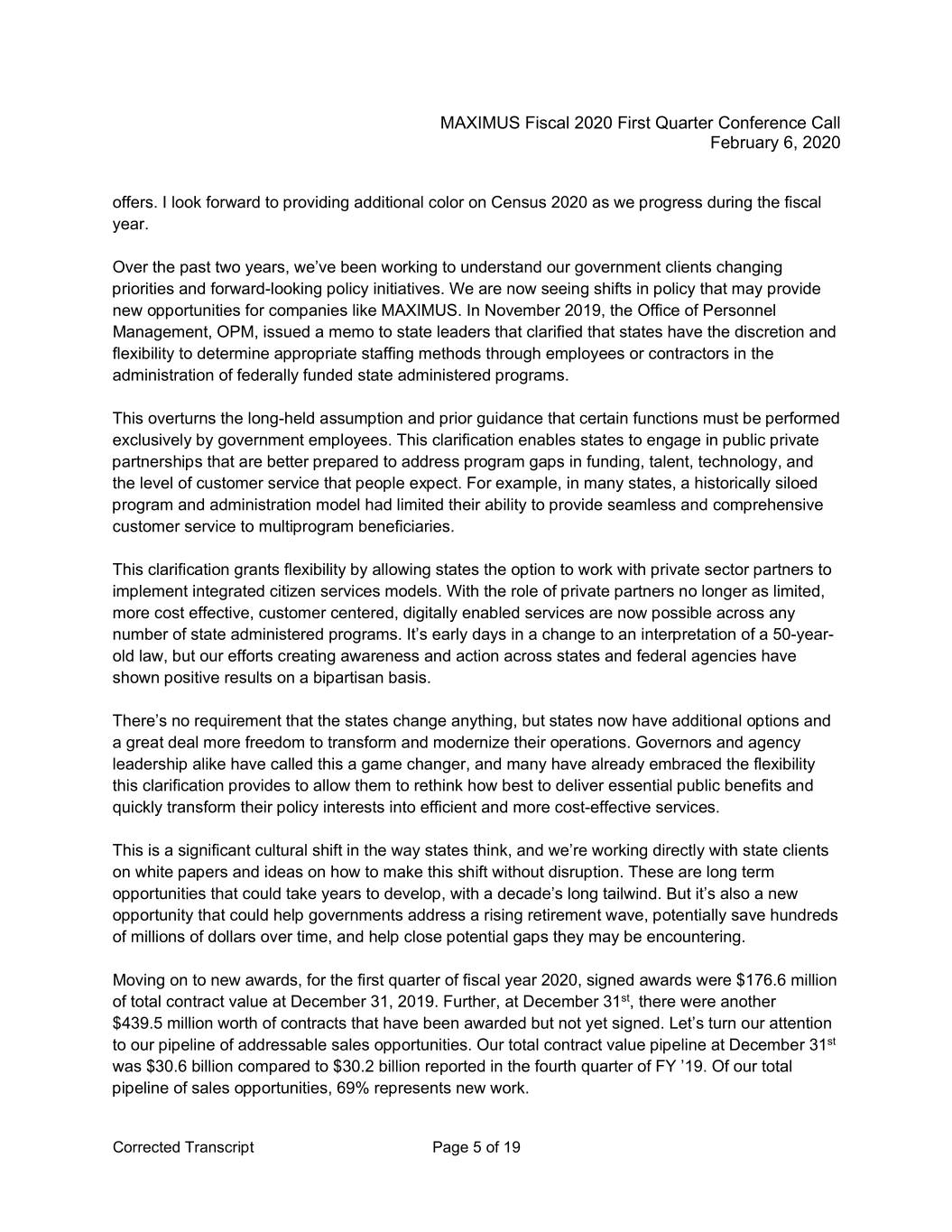
MAXIMUS Fiscal 2020 First Quarter Conference Call February 6, 2020 offers. I look forward to providing additional color on Census 2020 as we progress during the fiscal year. Over the past two years, we’ve been working to understand our government clients changing priorities and forward-looking policy initiatives. We are now seeing shifts in policy that may provide new opportunities for companies like MAXIMUS. In November 2019, the Office of Personnel Management, OPM, issued a memo to state leaders that clarified that states have the discretion and flexibility to determine appropriate staffing methods through employees or contractors in the administration of federally funded state administered programs. This overturns the long-held assumption and prior guidance that certain functions must be performed exclusively by government employees. This clarification enables states to engage in public private partnerships that are better prepared to address program gaps in funding, talent, technology, and the level of customer service that people expect. For example, in many states, a historically siloed program and administration model had limited their ability to provide seamless and comprehensive customer service to multiprogram beneficiaries. This clarification grants flexibility by allowing states the option to work with private sector partners to implement integrated citizen services models. With the role of private partners no longer as limited, more cost effective, customer centered, digitally enabled services are now possible across any number of state administered programs. It’s early days in a change to an interpretation of a 50-year- old law, but our efforts creating awareness and action across states and federal agencies have shown positive results on a bipartisan basis. There’s no requirement that the states change anything, but states now have additional options and a great deal more freedom to transform and modernize their operations. Governors and agency leadership alike have called this a game changer, and many have already embraced the flexibility this clarification provides to allow them to rethink how best to deliver essential public benefits and quickly transform their policy interests into efficient and more cost-effective services. This is a significant cultural shift in the way states think, and we’re working directly with state clients on white papers and ideas on how to make this shift without disruption. These are long term opportunities that could take years to develop, with a decade’s long tailwind. But it’s also a new opportunity that could help governments address a rising retirement wave, potentially save hundreds of millions of dollars over time, and help close potential gaps they may be encountering. Moving on to new awards, for the first quarter of fiscal year 2020, signed awards were $176.6 million of total contract value at December 31, 2019. Further, at December 31st, there were another $439.5 million worth of contracts that have been awarded but not yet signed. Let’s turn our attention to our pipeline of addressable sales opportunities. Our total contract value pipeline at December 31st was $30.6 billion compared to $30.2 billion reported in the fourth quarter of FY ’19. Of our total pipeline of sales opportunities, 69% represents new work. Corrected Transcript Page 5 of 19
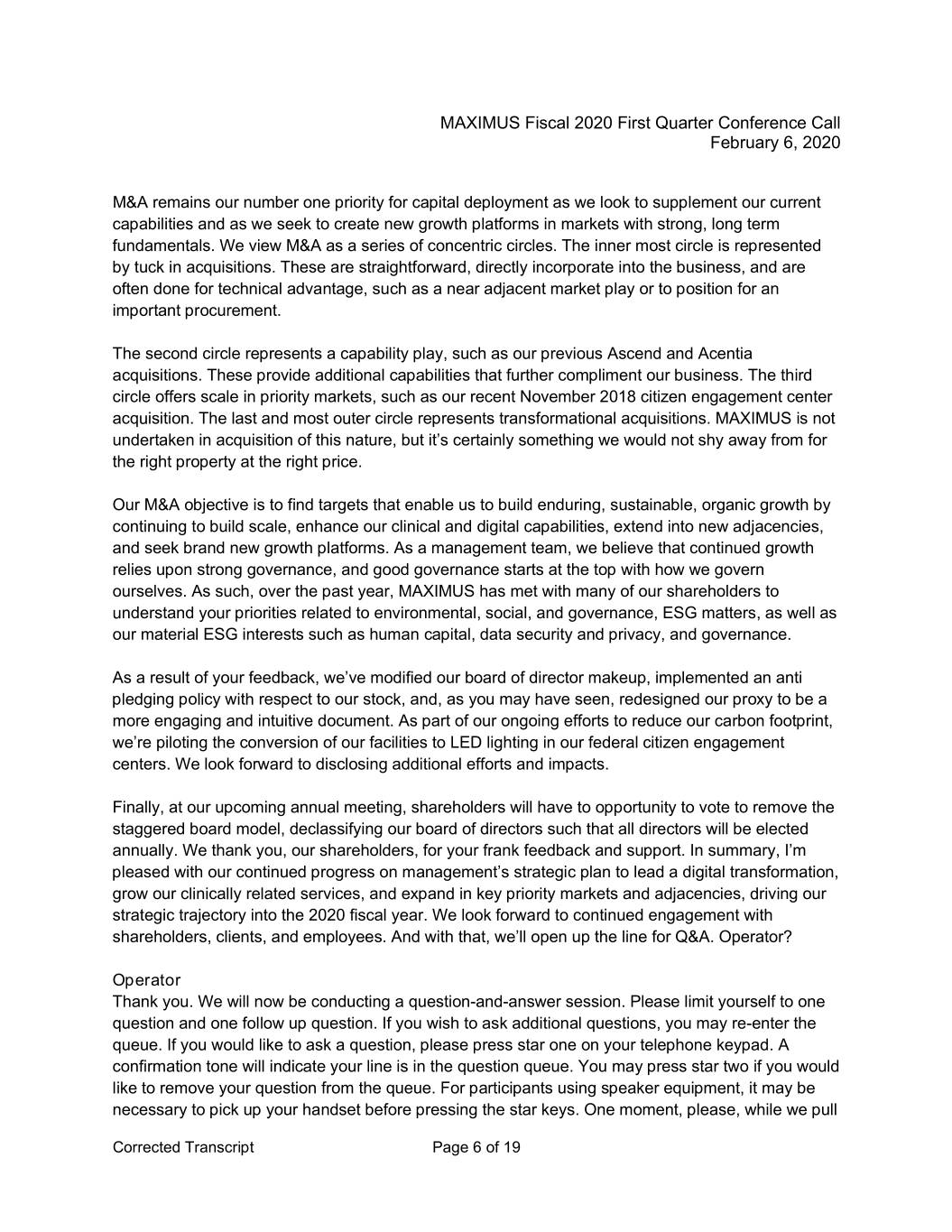
MAXIMUS Fiscal 2020 First Quarter Conference Call February 6, 2020 M&A remains our number one priority for capital deployment as we look to supplement our current capabilities and as we seek to create new growth platforms in markets with strong, long term fundamentals. We view M&A as a series of concentric circles. The inner most circle is represented by tuck in acquisitions. These are straightforward, directly incorporate into the business, and are often done for technical advantage, such as a near adjacent market play or to position for an important procurement. The second circle represents a capability play, such as our previous Ascend and Acentia acquisitions. These provide additional capabilities that further compliment our business. The third circle offers scale in priority markets, such as our recent November 2018 citizen engagement center acquisition. The last and most outer circle represents transformational acquisitions. MAXIMUS is not undertaken in acquisition of this nature, but it’s certainly something we would not shy away from for the right property at the right price. Our M&A objective is to find targets that enable us to build enduring, sustainable, organic growth by continuing to build scale, enhance our clinical and digital capabilities, extend into new adjacencies, and seek brand new growth platforms. As a management team, we believe that continued growth relies upon strong governance, and good governance starts at the top with how we govern ourselves. As such, over the past year, MAXIMUS has met with many of our shareholders to understand your priorities related to environmental, social, and governance, ESG matters, as well as our material ESG interests such as human capital, data security and privacy, and governance. As a result of your feedback, we’ve modified our board of director makeup, implemented an anti pledging policy with respect to our stock, and, as you may have seen, redesigned our proxy to be a more engaging and intuitive document. As part of our ongoing efforts to reduce our carbon footprint, we’re piloting the conversion of our facilities to LED lighting in our federal citizen engagement centers. We look forward to disclosing additional efforts and impacts. Finally, at our upcoming annual meeting, shareholders will have to opportunity to vote to remove the staggered board model, declassifying our board of directors such that all directors will be elected annually. We thank you, our shareholders, for your frank feedback and support. In summary, I’m pleased with our continued progress on management’s strategic plan to lead a digital transformation, grow our clinically related services, and expand in key priority markets and adjacencies, driving our strategic trajectory into the 2020 fiscal year. We look forward to continued engagement with shareholders, clients, and employees. And with that, we’ll open up the line for Q&A. Operator? Operator Thank you. We will now be conducting a question-and-answer session. Please limit yourself to one question and one follow up question. If you wish to ask additional questions, you may re-enter the queue. If you would like to ask a question, please press star one on your telephone keypad. A confirmation tone will indicate your line is in the question queue. You may press star two if you would like to remove your question from the queue. For participants using speaker equipment, it may be necessary to pick up your handset before pressing the star keys. One moment, please, while we pull Corrected Transcript Page 6 of 19
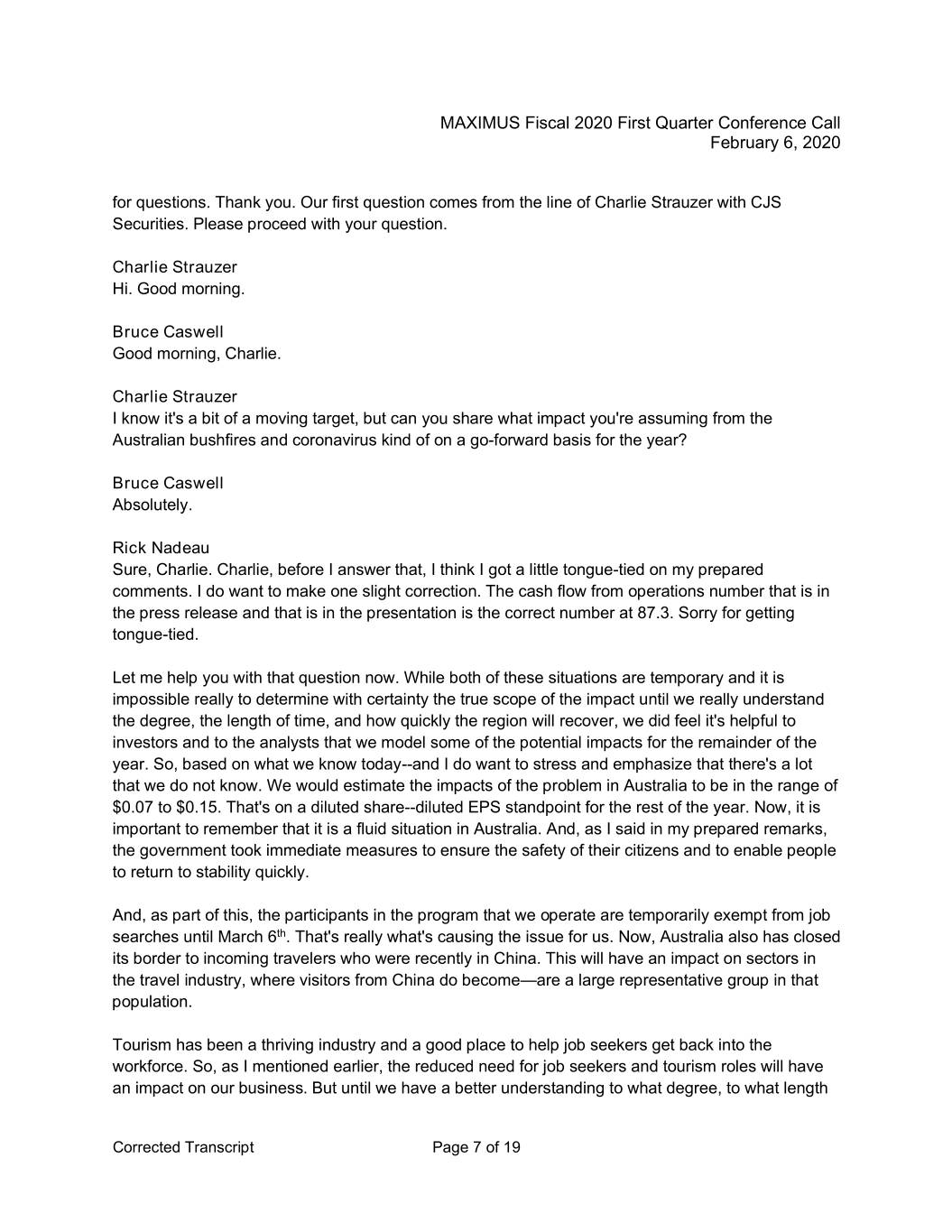
MAXIMUS Fiscal 2020 First Quarter Conference Call February 6, 2020 for questions. Thank you. Our first question comes from the line of Charlie Strauzer with CJS Securities. Please proceed with your question. Charlie Strauzer Hi. Good morning. Bruce Caswell Good morning, Charlie. Charlie Strauzer I know it's a bit of a moving target, but can you share what impact you're assuming from the Australian bushfires and coronavirus kind of on a go-forward basis for the year? Bruce Caswell Absolutely. Rick Nadeau Sure, Charlie. Charlie, before I answer that, I think I got a little tongue-tied on my prepared comments. I do want to make one slight correction. The cash flow from operations number that is in the press release and that is in the presentation is the correct number at 87.3. Sorry for getting tongue-tied. Let me help you with that question now. While both of these situations are temporary and it is impossible really to determine with certainty the true scope of the impact until we really understand the degree, the length of time, and how quickly the region will recover, we did feel it's helpful to investors and to the analysts that we model some of the potential impacts for the remainder of the year. So, based on what we know today--and I do want to stress and emphasize that there's a lot that we do not know. We would estimate the impacts of the problem in Australia to be in the range of $0.07 to $0.15. That's on a diluted share--diluted EPS standpoint for the rest of the year. Now, it is important to remember that it is a fluid situation in Australia. And, as I said in my prepared remarks, the government took immediate measures to ensure the safety of their citizens and to enable people to return to stability quickly. And, as part of this, the participants in the program that we operate are temporarily exempt from job searches until March 6th. That's really what's causing the issue for us. Now, Australia also has closed its border to incoming travelers who were recently in China. This will have an impact on sectors in the travel industry, where visitors from China do become—are a large representative group in that population. Tourism has been a thriving industry and a good place to help job seekers get back into the workforce. So, as I mentioned earlier, the reduced need for job seekers and tourism roles will have an impact on our business. But until we have a better understanding to what degree, to what length Corrected Transcript Page 7 of 19

MAXIMUS Fiscal 2020 First Quarter Conference Call February 6, 2020 of time, how quickly the region will recover, it really is not possible with certainty to determine what the ultimate impact will be. And lastly, I really--Bruce and I would like to thank our team in Australia. They responded immediately to help the community there by contacting all of our customers to offer support and mobilize resources such as psychologists to help in the most affected areas. The company's employees funded not-for-profit, the MAXIMUS--I'm sorry, the company's MAXIMUS foundation in Australia also raised $50,000 for the benefit of the bushfire relief efforts. That answer your question, Charlie? Charlie Strauzer That's great. Thank you very much, Rick. And then just a follow-up for Bruce if I could. You talked a little bit about the M&A concentric circles. And, obviously, with the policy change that you mentioned, is that going to be an area of focus of trying to find companies to buy? And what does the pipeline look like currently? Thanks. Bruce Caswell Sure. We see a lot of opportunities that are brought to us. And I think I've said before that we're always looking at the characteristics of these deals in terms of what they really mean to the business in the long term. We want to make sure that, as we look at specific opportunities, there really no more than about two adjacencies from our core, they've got a reputation for quality, they can provide sustainable revenue and the appropriate growth rate, good sustainable net margins, at least in the high single digits. A strong cultural fit the company, as well. So, we've been very selective as we've looked at opportunities, and further, we've tried to be a bit more proactive, if you will, in our M&A strategy. So, as we're looking down the road and we are identifying areas where we can strengthen the company in terms of our technology assets and digital assets, where we can become more clinical in the work that we do, but also where we can get into new markets, we've begun dialogue with companies that may not currently be active in the market with the hopes that, as things evolve over the coming years, they think about MAXIMUS as a home for a portion of their business. As it relates to the specific policy, I'd be happy to address a little bit more on the OPM guidance that I mentioned in my remarks or any other potential policy shifts there. Of course, there have been the Medicaid block grant guidance that the administration has provided recently, as well, which we can speculate about. So, is there any more specific area of policy that you're interested in as it might relate to that strategy, Charlie? Charlie Strauzer No. I was just thinking just more in terms of the M&A company--types of companies you would try to buy that would support those new policies. Corrected Transcript Page 8 of 19
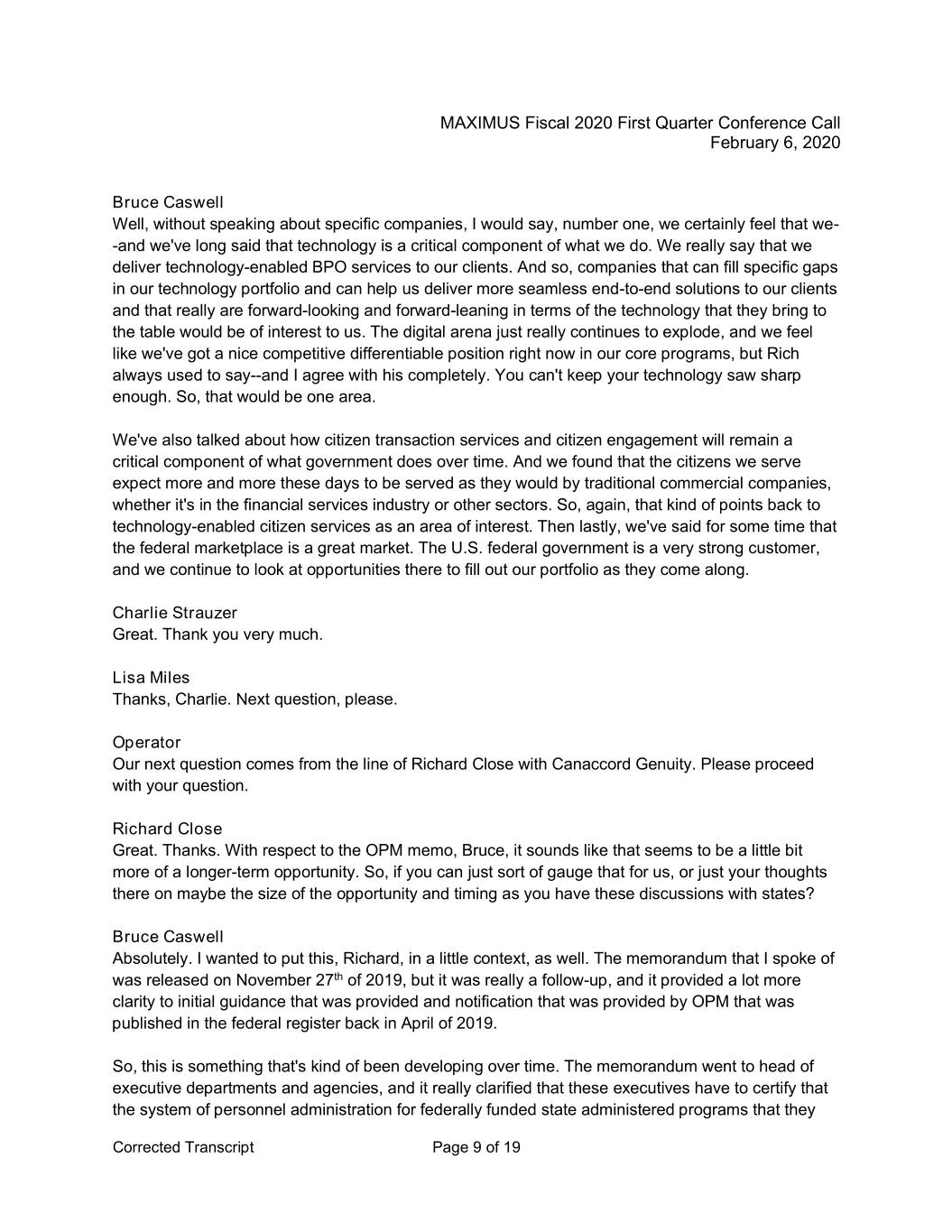
MAXIMUS Fiscal 2020 First Quarter Conference Call February 6, 2020 Bruce Caswell Well, without speaking about specific companies, I would say, number one, we certainly feel that we- -and we've long said that technology is a critical component of what we do. We really say that we deliver technology-enabled BPO services to our clients. And so, companies that can fill specific gaps in our technology portfolio and can help us deliver more seamless end-to-end solutions to our clients and that really are forward-looking and forward-leaning in terms of the technology that they bring to the table would be of interest to us. The digital arena just really continues to explode, and we feel like we've got a nice competitive differentiable position right now in our core programs, but Rich always used to say--and I agree with his completely. You can't keep your technology saw sharp enough. So, that would be one area. We've also talked about how citizen transaction services and citizen engagement will remain a critical component of what government does over time. And we found that the citizens we serve expect more and more these days to be served as they would by traditional commercial companies, whether it's in the financial services industry or other sectors. So, again, that kind of points back to technology-enabled citizen services as an area of interest. Then lastly, we've said for some time that the federal marketplace is a great market. The U.S. federal government is a very strong customer, and we continue to look at opportunities there to fill out our portfolio as they come along. Charlie Strauzer Great. Thank you very much. Lisa Miles Thanks, Charlie. Next question, please. Operator Our next question comes from the line of Richard Close with Canaccord Genuity. Please proceed with your question. Richard Close Great. Thanks. With respect to the OPM memo, Bruce, it sounds like that seems to be a little bit more of a longer-term opportunity. So, if you can just sort of gauge that for us, or just your thoughts there on maybe the size of the opportunity and timing as you have these discussions with states? Bruce Caswell Absolutely. I wanted to put this, Richard, in a little context, as well. The memorandum that I spoke of was released on November 27th of 2019, but it was really a follow-up, and it provided a lot more clarity to initial guidance that was provided and notification that was provided by OPM that was published in the federal register back in April of 2019. So, this is something that's kind of been developing over time. The memorandum went to head of executive departments and agencies, and it really clarified that these executives have to certify that the system of personnel administration for federally funded state administered programs that they Corrected Transcript Page 9 of 19
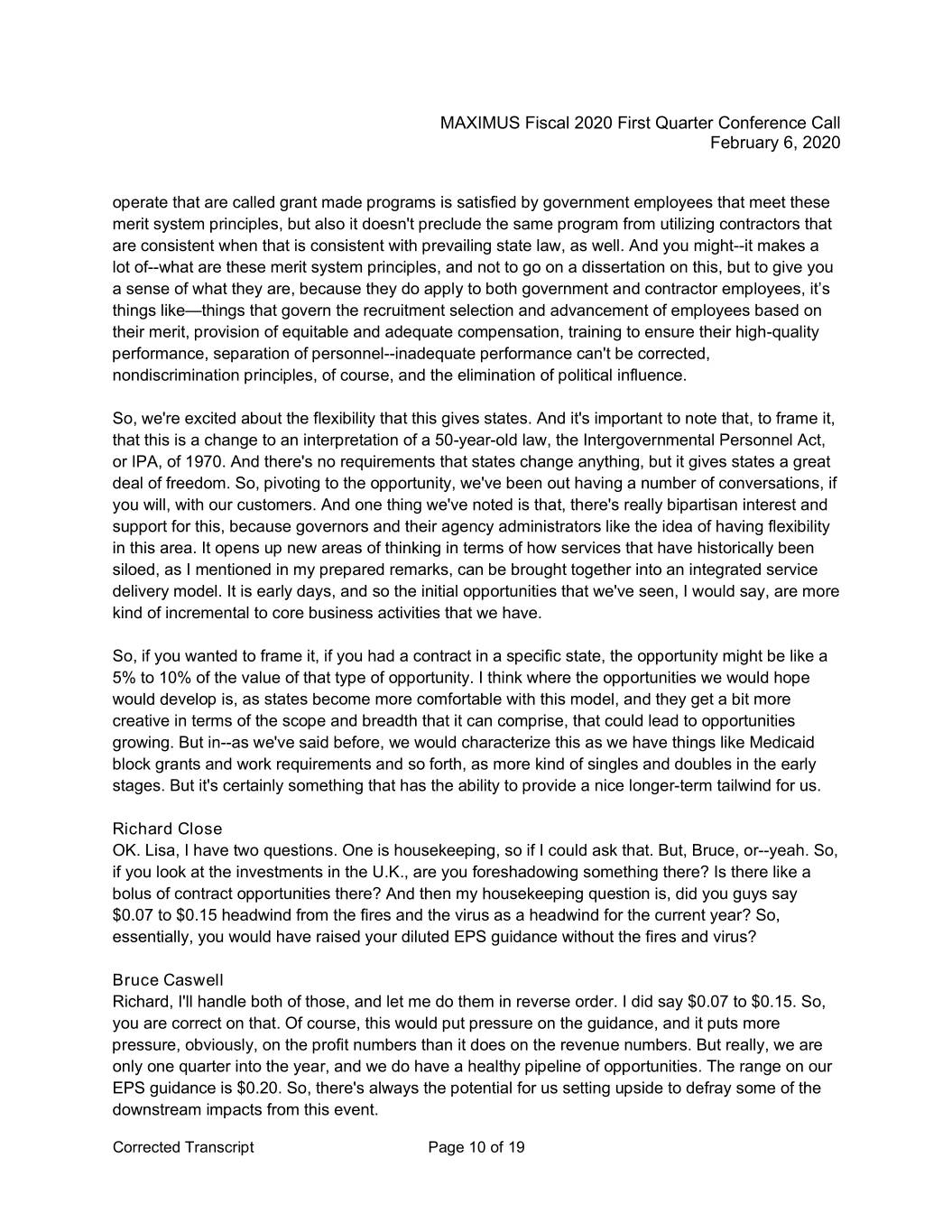
MAXIMUS Fiscal 2020 First Quarter Conference Call February 6, 2020 operate that are called grant made programs is satisfied by government employees that meet these merit system principles, but also it doesn't preclude the same program from utilizing contractors that are consistent when that is consistent with prevailing state law, as well. And you might--it makes a lot of--what are these merit system principles, and not to go on a dissertation on this, but to give you a sense of what they are, because they do apply to both government and contractor employees, it’s things like—things that govern the recruitment selection and advancement of employees based on their merit, provision of equitable and adequate compensation, training to ensure their high-quality performance, separation of personnel--inadequate performance can't be corrected, nondiscrimination principles, of course, and the elimination of political influence. So, we're excited about the flexibility that this gives states. And it's important to note that, to frame it, that this is a change to an interpretation of a 50-year-old law, the Intergovernmental Personnel Act, or IPA, of 1970. And there's no requirements that states change anything, but it gives states a great deal of freedom. So, pivoting to the opportunity, we've been out having a number of conversations, if you will, with our customers. And one thing we've noted is that, there's really bipartisan interest and support for this, because governors and their agency administrators like the idea of having flexibility in this area. It opens up new areas of thinking in terms of how services that have historically been siloed, as I mentioned in my prepared remarks, can be brought together into an integrated service delivery model. It is early days, and so the initial opportunities that we've seen, I would say, are more kind of incremental to core business activities that we have. So, if you wanted to frame it, if you had a contract in a specific state, the opportunity might be like a 5% to 10% of the value of that type of opportunity. I think where the opportunities we would hope would develop is, as states become more comfortable with this model, and they get a bit more creative in terms of the scope and breadth that it can comprise, that could lead to opportunities growing. But in--as we've said before, we would characterize this as we have things like Medicaid block grants and work requirements and so forth, as more kind of singles and doubles in the early stages. But it's certainly something that has the ability to provide a nice longer-term tailwind for us. Richard Close OK. Lisa, I have two questions. One is housekeeping, so if I could ask that. But, Bruce, or--yeah. So, if you look at the investments in the U.K., are you foreshadowing something there? Is there like a bolus of contract opportunities there? And then my housekeeping question is, did you guys say $0.07 to $0.15 headwind from the fires and the virus as a headwind for the current year? So, essentially, you would have raised your diluted EPS guidance without the fires and virus? Bruce Caswell Richard, I'll handle both of those, and let me do them in reverse order. I did say $0.07 to $0.15. So, you are correct on that. Of course, this would put pressure on the guidance, and it puts more pressure, obviously, on the profit numbers than it does on the revenue numbers. But really, we are only one quarter into the year, and we do have a healthy pipeline of opportunities. The range on our EPS guidance is $0.20. So, there's always the potential for us setting upside to defray some of the downstream impacts from this event. Corrected Transcript Page 10 of 19

MAXIMUS Fiscal 2020 First Quarter Conference Call February 6, 2020 I did want to make sure that I stressed again that this is a temporary situation, but it really is too early to determine the full impact because of the uncertainty that's involved with it. I mean, these events are still unfolding, and we really don't know. But--we're only one quarter into it--into the year, and I think we feel like the guidance range is appropriate, and it is a $0.20 range. On the other issue of the U.K., both Bruce and I have spent time in the U.K., and we've met with key stakeholders and are devoting a lot of time to discussions with the team. We both believe that there is a clear demand for partners like MAXIMUS who are financially stable and have a strong track record of delivery. We see a number of vital opportunities that will diversify our portfolio while leveraging the core skills that we have, as well as our digital and our technology assets. So, I think we believe it's the right time to invest more heavily in the U.K., and that it is time for us to start looking at a variety of opportunities. Some of these have longer runways than others. But I think, basically, the bottom line is that our efforts could prove to be pivotal in expanding the portfolio in the United Kingdom, particularly since we are a very financially stable contractor. Richard Close Okay. Thank you very much. Appreciate that. Bruce Caswell Okay, sure. Lisa Miles Thanks, Richard. Next question, please. Operator Our next question comes from the line of Donald Hooker with KeyBanc Capital Markets. Please proceed with your question. Donald Hooker Great. Good morning. Well, I want to ask about the Medicaid block grant regulation. You mentioned earlier, there's a lot of puts and takes there. And would love to hear your opinion as how that might impact MAXIMUS if it went into effect over the next few years? Rick Nadeau Absolutely, Donald. I'll put on my hat as the resident policy wonk here a little bit and talk about that. Interestingly--first of all, it's important to note that this guidance on Medicaid block grants really applies to just a portion of the Medicaid population. So, it applies to adults without children. Back when we talked about the food stamp program, they have an acronym they use called ABAWD, Able Bodied Adults Without Dependence. So, these are adults without children that largely obtained coverage under the expansion of Medicaid. Corrected Transcript Page 11 of 19

MAXIMUS Fiscal 2020 First Quarter Conference Call February 6, 2020 Some folks have speculated that the block grant guidance is an effort by the Trump administration to kind of bring along those states that have not yet expanded Medicaid for those populations by giving them this additional flexibility. Now, as we talked about block grants in the past, they can be a double-edged sword, because on the one hand, they provide a lot more flexibility. On the other hand, they end up capping funding. And without going into the nuances of per capita funding cap versus CPI-based funding cap or various models, I think what we're seeing is states are cautious, right, about--and they're doing the ROI calculation to say, is it worth the benefit of having flexibility for these populations when I also understand the risk that I could end up having to fund more of this program myself, if it expands into down economy, and often, obviously, Medicaid expenses would outstrip other measures in a down economy. So, that said, populations that are not included in the block grant, and this is important, are children, people that qualify based on disability, people needing long-term care, folks that are 65 and over. So, that's the first point. The second point would be, with this flexibility comes also reduced federal oversight of managed care organizations, the ability to kind of custom tailor some of the Medicaid benefits like nonemergency medical transportation, and the EPSDT program, which covers folks up to 19 and 20 years old. States would have more flexibility there. Whereas we read the tea leaves, and it's very early in the process. There are a couple of states so far that have signaled that they have an interest in going in this direction, and I think that's Tennessee and Oklahoma. Others have been fairly cautious about it. And the commentary that I've read--and I think Matt Salo, who is the Executive Director of the National Association of Medicaid Directors put it well. He said that there are a lot of states that are concerned about losing funding, as I've mentioned, if federal dollars are constrained at all there. So, it's going to move at a glacial pace. I guess, the way we would consider it is, even with the normal implementation of this type of guidance, no state would get a waiver before 2021. So, you then have to bring the presidential election into the lens. And if there's a change in federal administrations, that could change its guidance. We're also sensing that there's going to be a likely litigation in this area. A number of folks have come out and take an issue with it. In fact, I think the House has been pretty vocal on this point. So, I would say stay tuned. You'll probably see a few small states begin the process. It's hard to say with the threat of litigation, whether it will come to its conclusion and have an impact anytime in the near term. All of that said, we have always been, I think, excellent at helping our state clients custom fit and tailor programs to their needs. And one of the programs we always kind of juxtaposed, if you will, with Medicaid is the children's health insurance program, which functions more as a block grant presently than Medicaid as an entitlement. And in the CHIP program, we've been able to achieve admirable accuracy rates and low error rates in the administration of that program all the way through the eligibility process. But if you consider Medicaid block granting in conjunction with the OPM guidance that we talked about will give us that ability to kind of provide similar services at the Medicaid level, should the state want to go in that Corrected Transcript Page 12 of 19
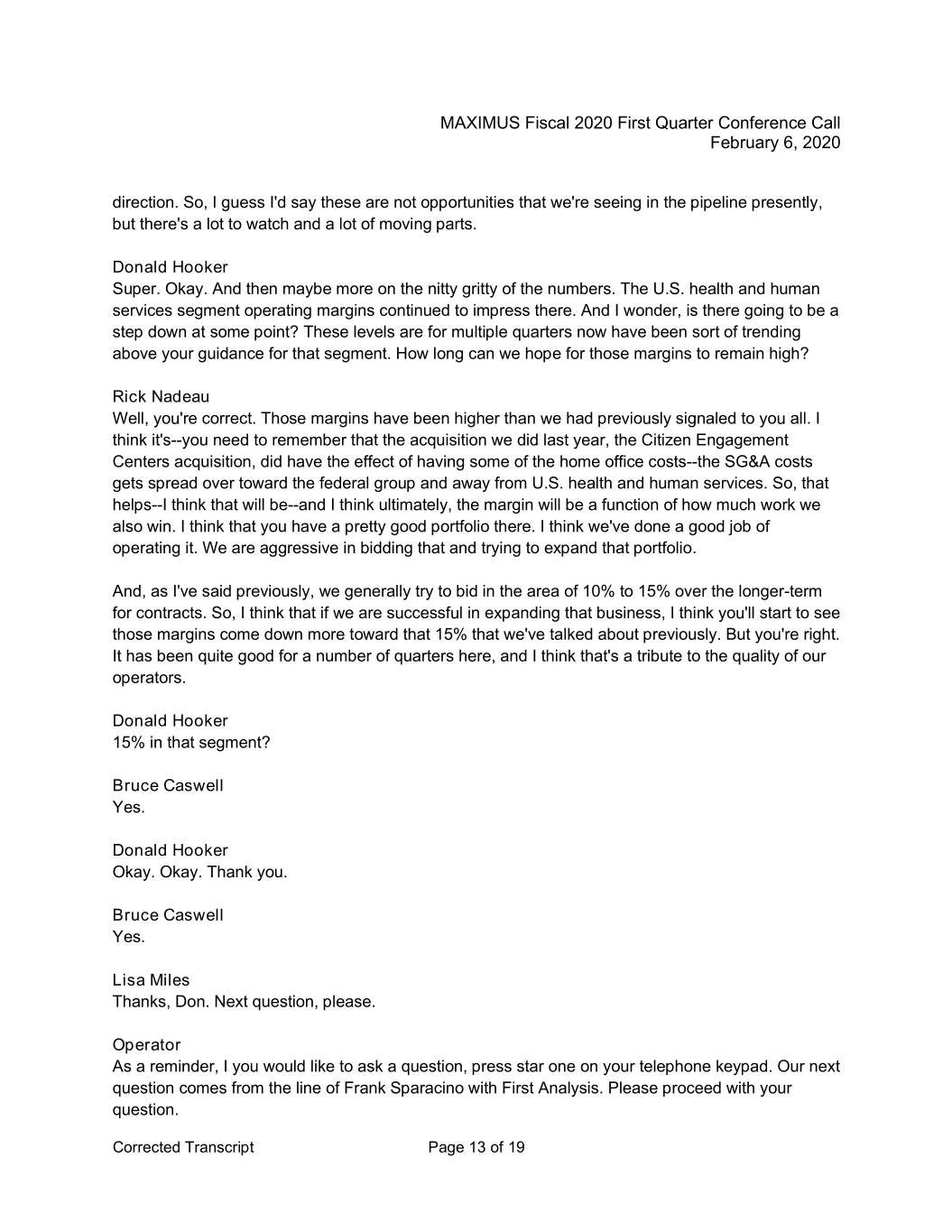
MAXIMUS Fiscal 2020 First Quarter Conference Call February 6, 2020 direction. So, I guess I'd say these are not opportunities that we're seeing in the pipeline presently, but there's a lot to watch and a lot of moving parts. Donald Hooker Super. Okay. And then maybe more on the nitty gritty of the numbers. The U.S. health and human services segment operating margins continued to impress there. And I wonder, is there going to be a step down at some point? These levels are for multiple quarters now have been sort of trending above your guidance for that segment. How long can we hope for those margins to remain high? Rick Nadeau Well, you're correct. Those margins have been higher than we had previously signaled to you all. I think it's--you need to remember that the acquisition we did last year, the Citizen Engagement Centers acquisition, did have the effect of having some of the home office costs--the SG&A costs gets spread over toward the federal group and away from U.S. health and human services. So, that helps--I think that will be--and I think ultimately, the margin will be a function of how much work we also win. I think that you have a pretty good portfolio there. I think we've done a good job of operating it. We are aggressive in bidding that and trying to expand that portfolio. And, as I've said previously, we generally try to bid in the area of 10% to 15% over the longer-term for contracts. So, I think that if we are successful in expanding that business, I think you'll start to see those margins come down more toward that 15% that we've talked about previously. But you're right. It has been quite good for a number of quarters here, and I think that's a tribute to the quality of our operators. Donald Hooker 15% in that segment? Bruce Caswell Yes. Donald Hooker Okay. Okay. Thank you. Bruce Caswell Yes. Lisa Miles Thanks, Don. Next question, please. Operator As a reminder, I you would like to ask a question, press star one on your telephone keypad. Our next question comes from the line of Frank Sparacino with First Analysis. Please proceed with your question. Corrected Transcript Page 13 of 19
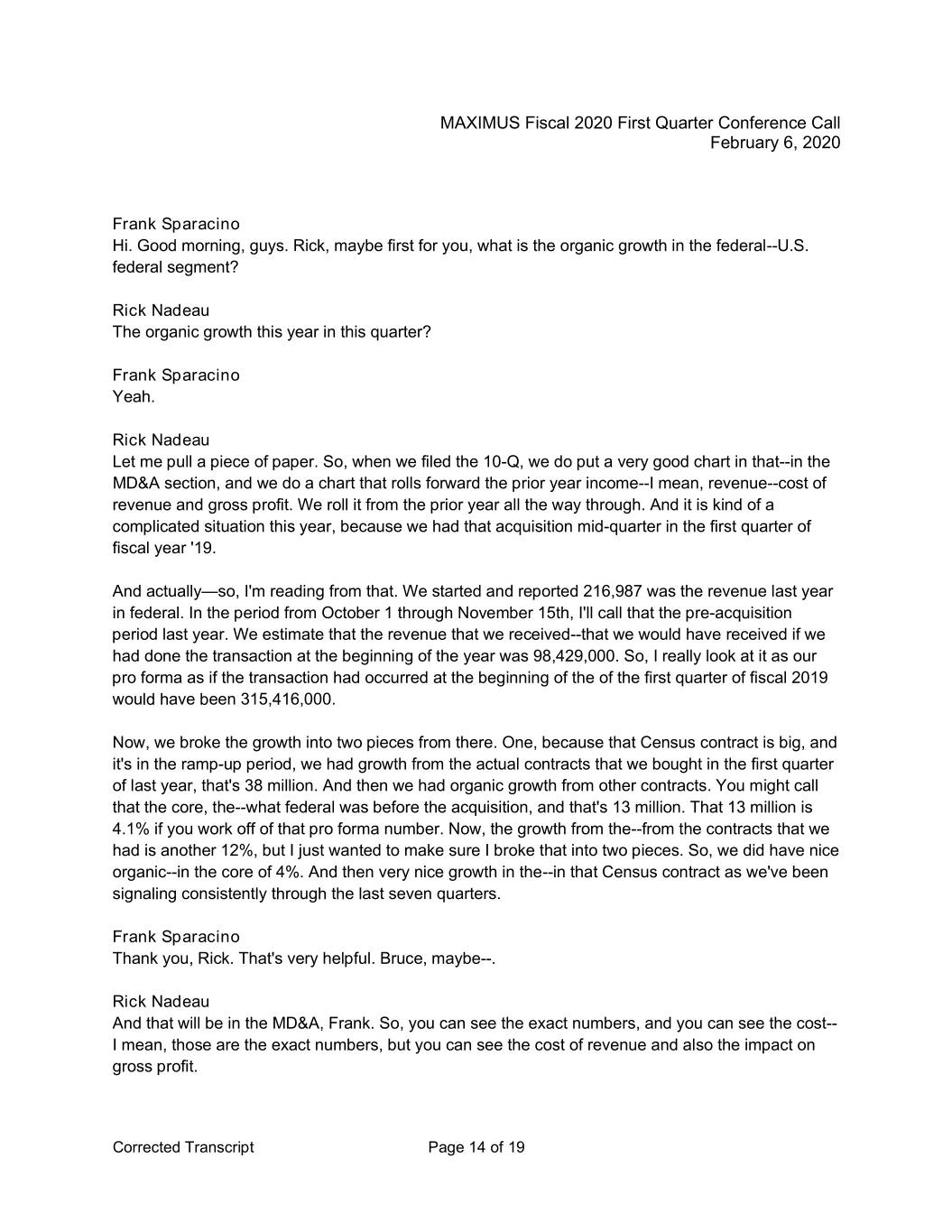
MAXIMUS Fiscal 2020 First Quarter Conference Call February 6, 2020 Frank Sparacino Hi. Good morning, guys. Rick, maybe first for you, what is the organic growth in the federal--U.S. federal segment? Rick Nadeau The organic growth this year in this quarter? Frank Sparacino Yeah. Rick Nadeau Let me pull a piece of paper. So, when we filed the 10-Q, we do put a very good chart in that--in the MD&A section, and we do a chart that rolls forward the prior year income--I mean, revenue--cost of revenue and gross profit. We roll it from the prior year all the way through. And it is kind of a complicated situation this year, because we had that acquisition mid-quarter in the first quarter of fiscal year '19. And actually—so, I'm reading from that. We started and reported 216,987 was the revenue last year in federal. In the period from October 1 through November 15th, I'll call that the pre-acquisition period last year. We estimate that the revenue that we received--that we would have received if we had done the transaction at the beginning of the year was 98,429,000. So, I really look at it as our pro forma as if the transaction had occurred at the beginning of the of the first quarter of fiscal 2019 would have been 315,416,000. Now, we broke the growth into two pieces from there. One, because that Census contract is big, and it's in the ramp-up period, we had growth from the actual contracts that we bought in the first quarter of last year, that's 38 million. And then we had organic growth from other contracts. You might call that the core, the--what federal was before the acquisition, and that's 13 million. That 13 million is 4.1% if you work off of that pro forma number. Now, the growth from the--from the contracts that we had is another 12%, but I just wanted to make sure I broke that into two pieces. So, we did have nice organic--in the core of 4%. And then very nice growth in the--in that Census contract as we've been signaling consistently through the last seven quarters. Frank Sparacino Thank you, Rick. That's very helpful. Bruce, maybe--. Rick Nadeau And that will be in the MD&A, Frank. So, you can see the exact numbers, and you can see the cost-- I mean, those are the exact numbers, but you can see the cost of revenue and also the impact on gross profit. Corrected Transcript Page 14 of 19
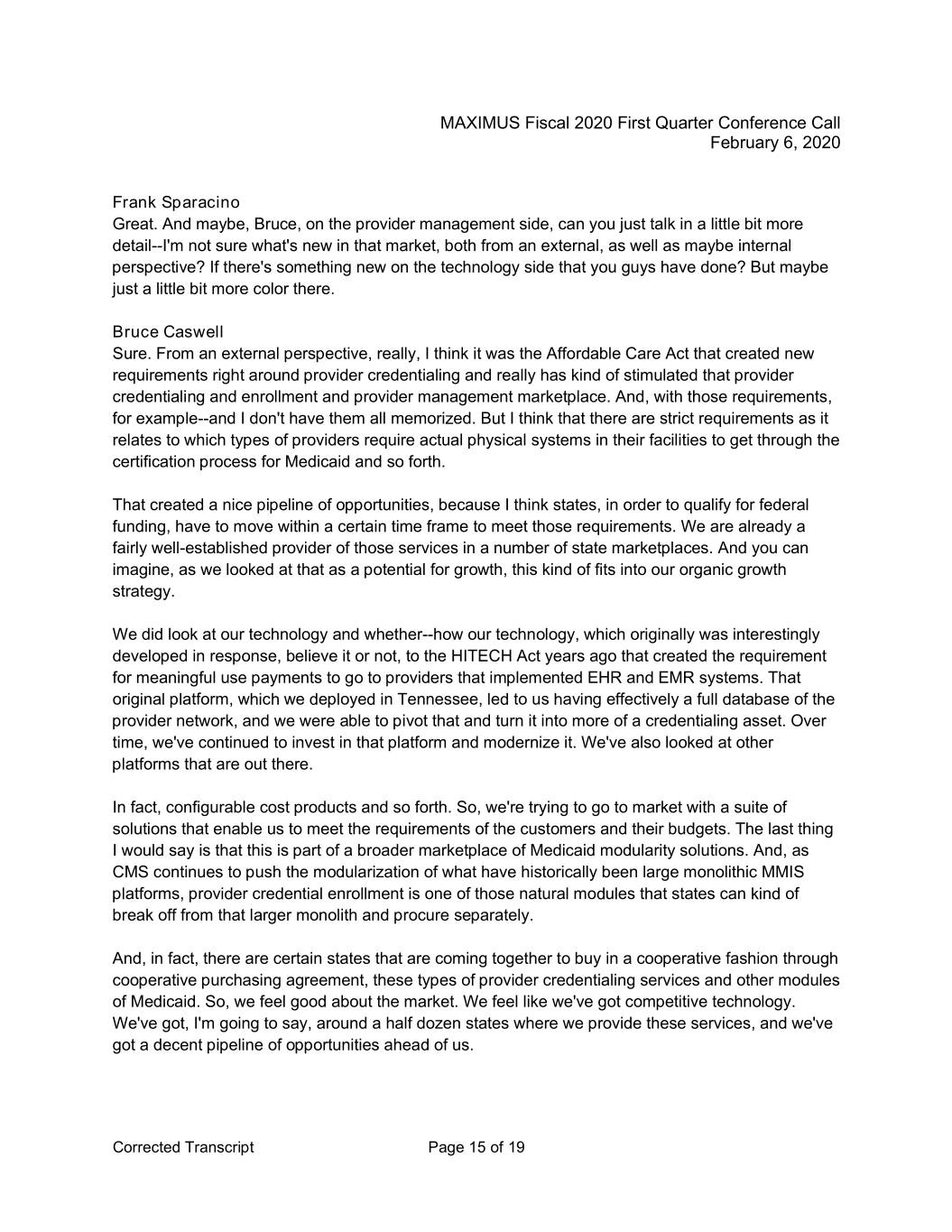
MAXIMUS Fiscal 2020 First Quarter Conference Call February 6, 2020 Frank Sparacino Great. And maybe, Bruce, on the provider management side, can you just talk in a little bit more detail--I'm not sure what's new in that market, both from an external, as well as maybe internal perspective? If there's something new on the technology side that you guys have done? But maybe just a little bit more color there. Bruce Caswell Sure. From an external perspective, really, I think it was the Affordable Care Act that created new requirements right around provider credentialing and really has kind of stimulated that provider credentialing and enrollment and provider management marketplace. And, with those requirements, for example--and I don't have them all memorized. But I think that there are strict requirements as it relates to which types of providers require actual physical systems in their facilities to get through the certification process for Medicaid and so forth. That created a nice pipeline of opportunities, because I think states, in order to qualify for federal funding, have to move within a certain time frame to meet those requirements. We are already a fairly well-established provider of those services in a number of state marketplaces. And you can imagine, as we looked at that as a potential for growth, this kind of fits into our organic growth strategy. We did look at our technology and whether--how our technology, which originally was interestingly developed in response, believe it or not, to the HITECH Act years ago that created the requirement for meaningful use payments to go to providers that implemented EHR and EMR systems. That original platform, which we deployed in Tennessee, led to us having effectively a full database of the provider network, and we were able to pivot that and turn it into more of a credentialing asset. Over time, we've continued to invest in that platform and modernize it. We've also looked at other platforms that are out there. In fact, configurable cost products and so forth. So, we're trying to go to market with a suite of solutions that enable us to meet the requirements of the customers and their budgets. The last thing I would say is that this is part of a broader marketplace of Medicaid modularity solutions. And, as CMS continues to push the modularization of what have historically been large monolithic MMIS platforms, provider credential enrollment is one of those natural modules that states can kind of break off from that larger monolith and procure separately. And, in fact, there are certain states that are coming together to buy in a cooperative fashion through cooperative purchasing agreement, these types of provider credentialing services and other modules of Medicaid. So, we feel good about the market. We feel like we've got competitive technology. We've got, I'm going to say, around a half dozen states where we provide these services, and we've got a decent pipeline of opportunities ahead of us. Corrected Transcript Page 15 of 19
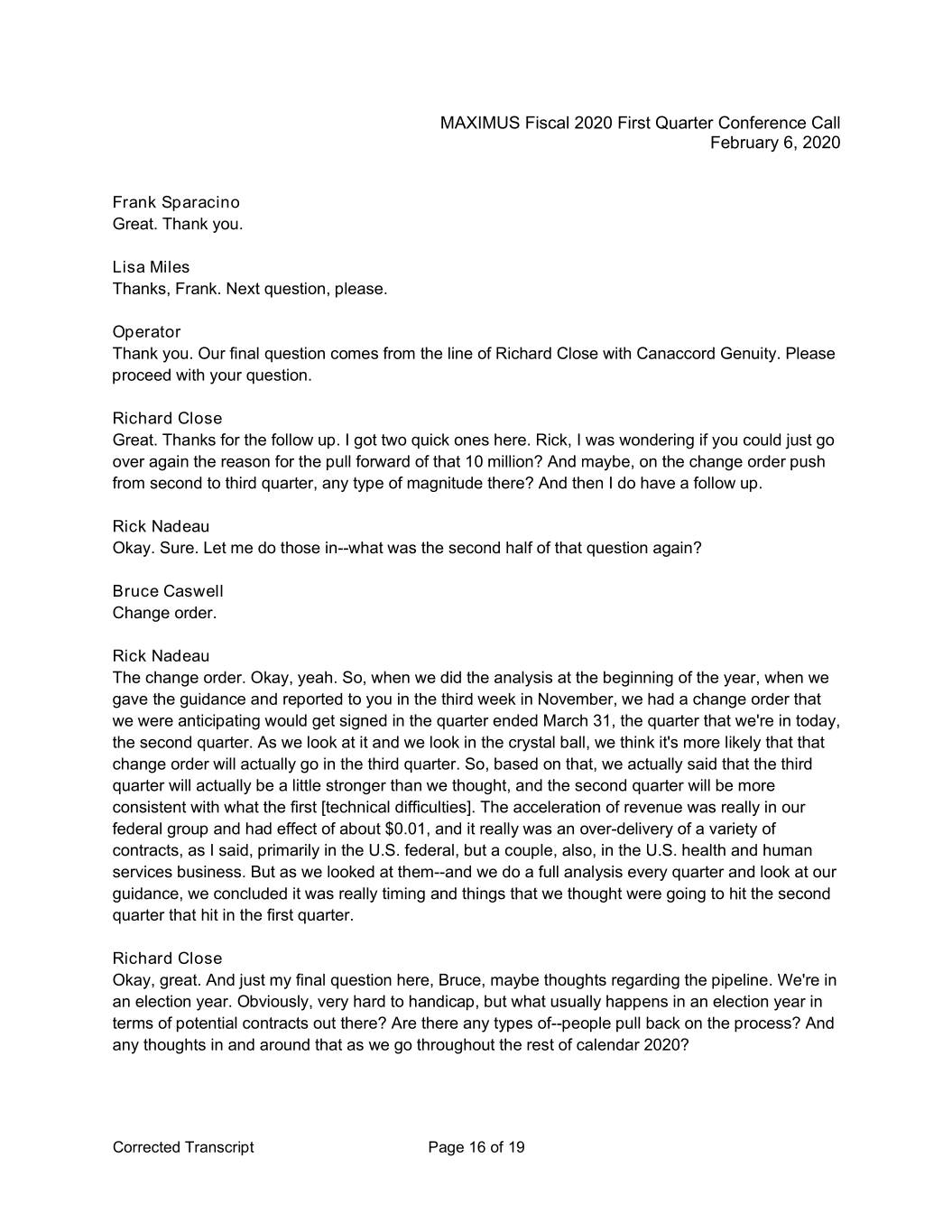
MAXIMUS Fiscal 2020 First Quarter Conference Call February 6, 2020 Frank Sparacino Great. Thank you. Lisa Miles Thanks, Frank. Next question, please. Operator Thank you. Our final question comes from the line of Richard Close with Canaccord Genuity. Please proceed with your question. Richard Close Great. Thanks for the follow up. I got two quick ones here. Rick, I was wondering if you could just go over again the reason for the pull forward of that 10 million? And maybe, on the change order push from second to third quarter, any type of magnitude there? And then I do have a follow up. Rick Nadeau Okay. Sure. Let me do those in--what was the second half of that question again? Bruce Caswell Change order. Rick Nadeau The change order. Okay, yeah. So, when we did the analysis at the beginning of the year, when we gave the guidance and reported to you in the third week in November, we had a change order that we were anticipating would get signed in the quarter ended March 31, the quarter that we're in today, the second quarter. As we look at it and we look in the crystal ball, we think it's more likely that that change order will actually go in the third quarter. So, based on that, we actually said that the third quarter will actually be a little stronger than we thought, and the second quarter will be more consistent with what the first [technical difficulties]. The acceleration of revenue was really in our federal group and had effect of about $0.01, and it really was an over-delivery of a variety of contracts, as I said, primarily in the U.S. federal, but a couple, also, in the U.S. health and human services business. But as we looked at them--and we do a full analysis every quarter and look at our guidance, we concluded it was really timing and things that we thought were going to hit the second quarter that hit in the first quarter. Richard Close Okay, great. And just my final question here, Bruce, maybe thoughts regarding the pipeline. We're in an election year. Obviously, very hard to handicap, but what usually happens in an election year in terms of potential contracts out there? Are there any types of--people pull back on the process? And any thoughts in and around that as we go throughout the rest of calendar 2020? Corrected Transcript Page 16 of 19
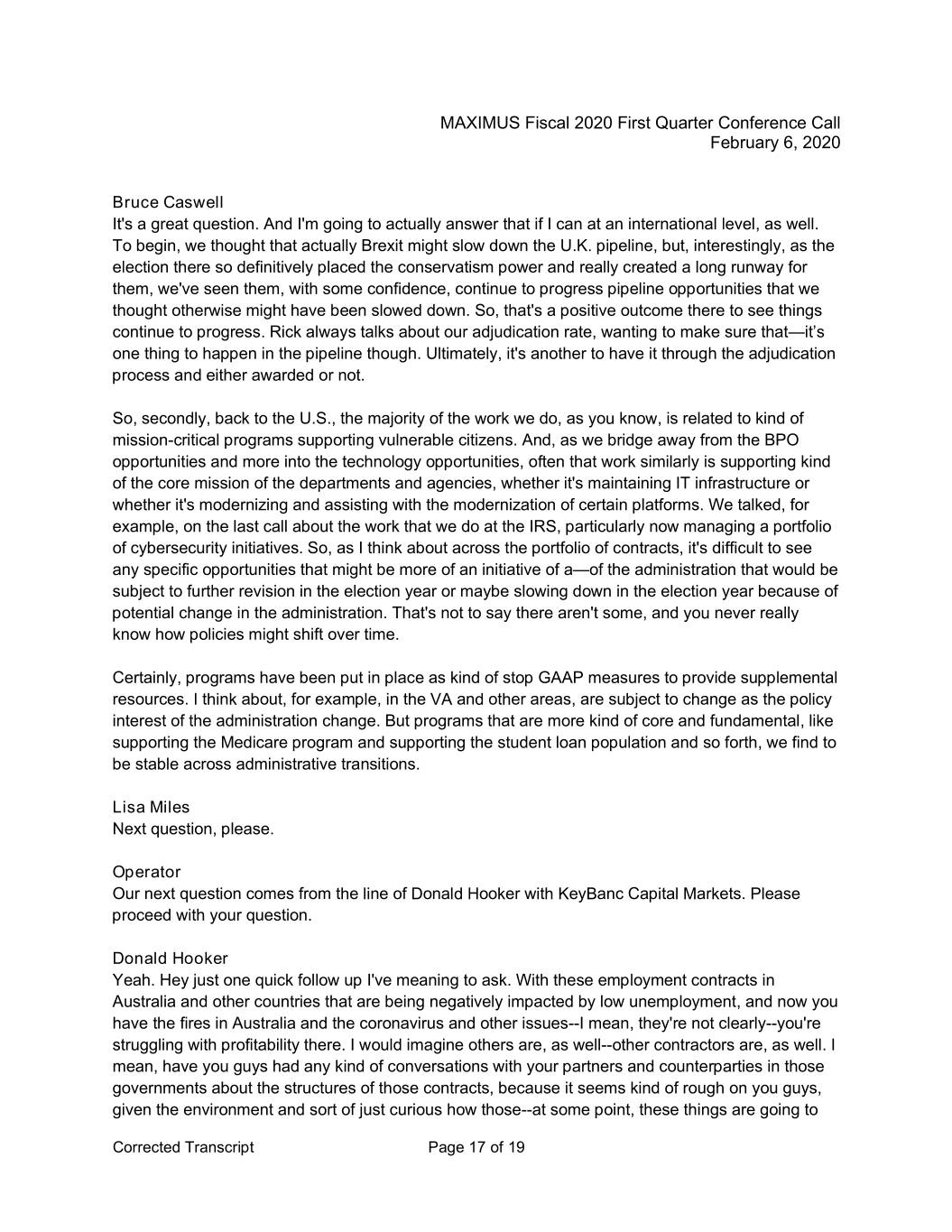
MAXIMUS Fiscal 2020 First Quarter Conference Call February 6, 2020 Bruce Caswell It's a great question. And I'm going to actually answer that if I can at an international level, as well. To begin, we thought that actually Brexit might slow down the U.K. pipeline, but, interestingly, as the election there so definitively placed the conservatism power and really created a long runway for them, we've seen them, with some confidence, continue to progress pipeline opportunities that we thought otherwise might have been slowed down. So, that's a positive outcome there to see things continue to progress. Rick always talks about our adjudication rate, wanting to make sure that—it’s one thing to happen in the pipeline though. Ultimately, it's another to have it through the adjudication process and either awarded or not. So, secondly, back to the U.S., the majority of the work we do, as you know, is related to kind of mission-critical programs supporting vulnerable citizens. And, as we bridge away from the BPO opportunities and more into the technology opportunities, often that work similarly is supporting kind of the core mission of the departments and agencies, whether it's maintaining IT infrastructure or whether it's modernizing and assisting with the modernization of certain platforms. We talked, for example, on the last call about the work that we do at the IRS, particularly now managing a portfolio of cybersecurity initiatives. So, as I think about across the portfolio of contracts, it's difficult to see any specific opportunities that might be more of an initiative of a—of the administration that would be subject to further revision in the election year or maybe slowing down in the election year because of potential change in the administration. That's not to say there aren't some, and you never really know how policies might shift over time. Certainly, programs have been put in place as kind of stop GAAP measures to provide supplemental resources. I think about, for example, in the VA and other areas, are subject to change as the policy interest of the administration change. But programs that are more kind of core and fundamental, like supporting the Medicare program and supporting the student loan population and so forth, we find to be stable across administrative transitions. Lisa Miles Next question, please. Operator Our next question comes from the line of Donald Hooker with KeyBanc Capital Markets. Please proceed with your question. Donald Hooker Yeah. Hey just one quick follow up I've meaning to ask. With these employment contracts in Australia and other countries that are being negatively impacted by low unemployment, and now you have the fires in Australia and the coronavirus and other issues--I mean, they're not clearly--you're struggling with profitability there. I would imagine others are, as well--other contractors are, as well. I mean, have you guys had any kind of conversations with your partners and counterparties in those governments about the structures of those contracts, because it seems kind of rough on you guys, given the environment and sort of just curious how those--at some point, these things are going to Corrected Transcript Page 17 of 19
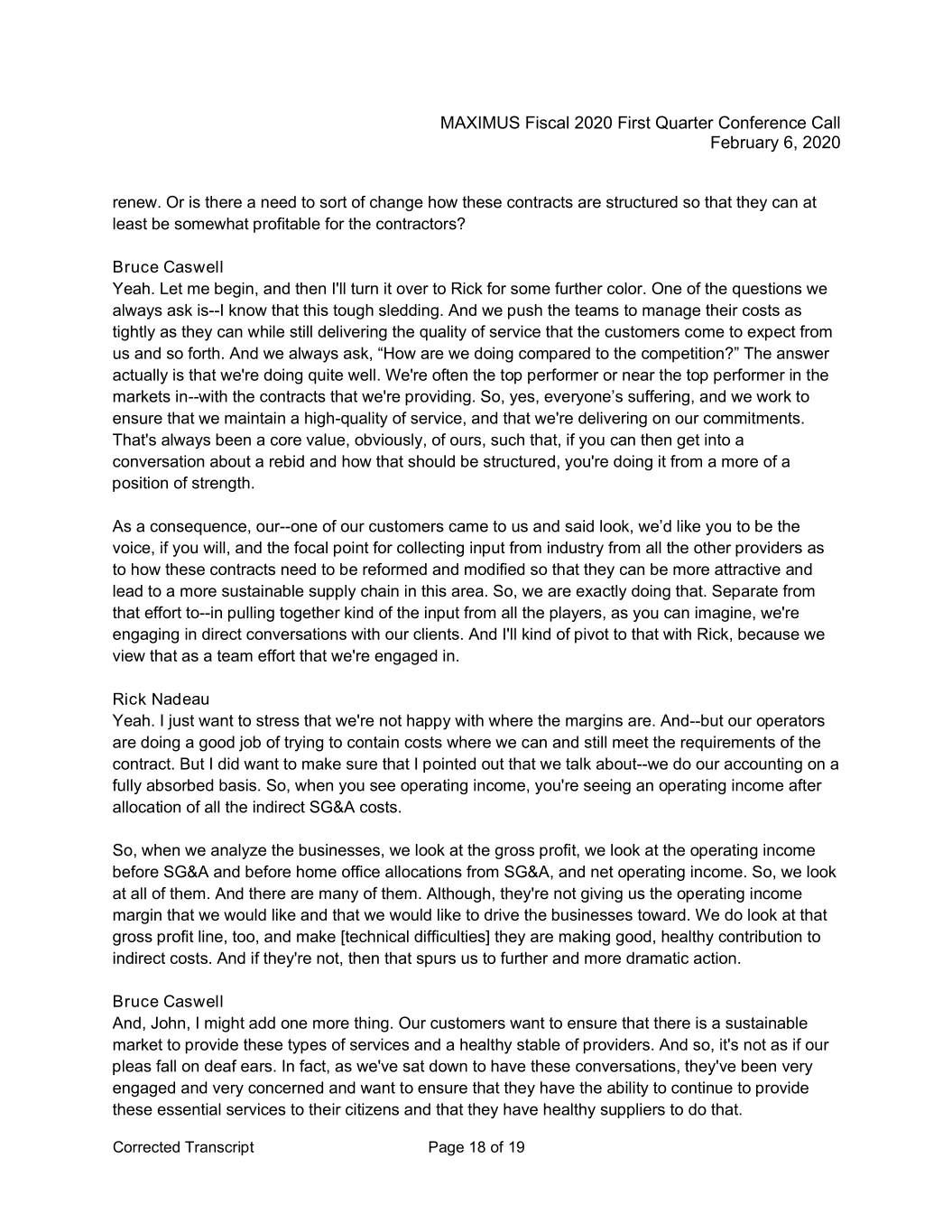
MAXIMUS Fiscal 2020 First Quarter Conference Call February 6, 2020 renew. Or is there a need to sort of change how these contracts are structured so that they can at least be somewhat profitable for the contractors? Bruce Caswell Yeah. Let me begin, and then I'll turn it over to Rick for some further color. One of the questions we always ask is--I know that this tough sledding. And we push the teams to manage their costs as tightly as they can while still delivering the quality of service that the customers come to expect from us and so forth. And we always ask, “How are we doing compared to the competition?” The answer actually is that we're doing quite well. We're often the top performer or near the top performer in the markets in--with the contracts that we're providing. So, yes, everyone’s suffering, and we work to ensure that we maintain a high-quality of service, and that we're delivering on our commitments. That's always been a core value, obviously, of ours, such that, if you can then get into a conversation about a rebid and how that should be structured, you're doing it from a more of a position of strength. As a consequence, our--one of our customers came to us and said look, we’d like you to be the voice, if you will, and the focal point for collecting input from industry from all the other providers as to how these contracts need to be reformed and modified so that they can be more attractive and lead to a more sustainable supply chain in this area. So, we are exactly doing that. Separate from that effort to--in pulling together kind of the input from all the players, as you can imagine, we're engaging in direct conversations with our clients. And I'll kind of pivot to that with Rick, because we view that as a team effort that we're engaged in. Rick Nadeau Yeah. I just want to stress that we're not happy with where the margins are. And--but our operators are doing a good job of trying to contain costs where we can and still meet the requirements of the contract. But I did want to make sure that I pointed out that we talk about--we do our accounting on a fully absorbed basis. So, when you see operating income, you're seeing an operating income after allocation of all the indirect SG&A costs. So, when we analyze the businesses, we look at the gross profit, we look at the operating income before SG&A and before home office allocations from SG&A, and net operating income. So, we look at all of them. And there are many of them. Although, they're not giving us the operating income margin that we would like and that we would like to drive the businesses toward. We do look at that gross profit line, too, and make [technical difficulties] they are making good, healthy contribution to indirect costs. And if they're not, then that spurs us to further and more dramatic action. Bruce Caswell And, John, I might add one more thing. Our customers want to ensure that there is a sustainable market to provide these types of services and a healthy stable of providers. And so, it's not as if our pleas fall on deaf ears. In fact, as we've sat down to have these conversations, they've been very engaged and very concerned and want to ensure that they have the ability to continue to provide these essential services to their citizens and that they have healthy suppliers to do that. Corrected Transcript Page 18 of 19
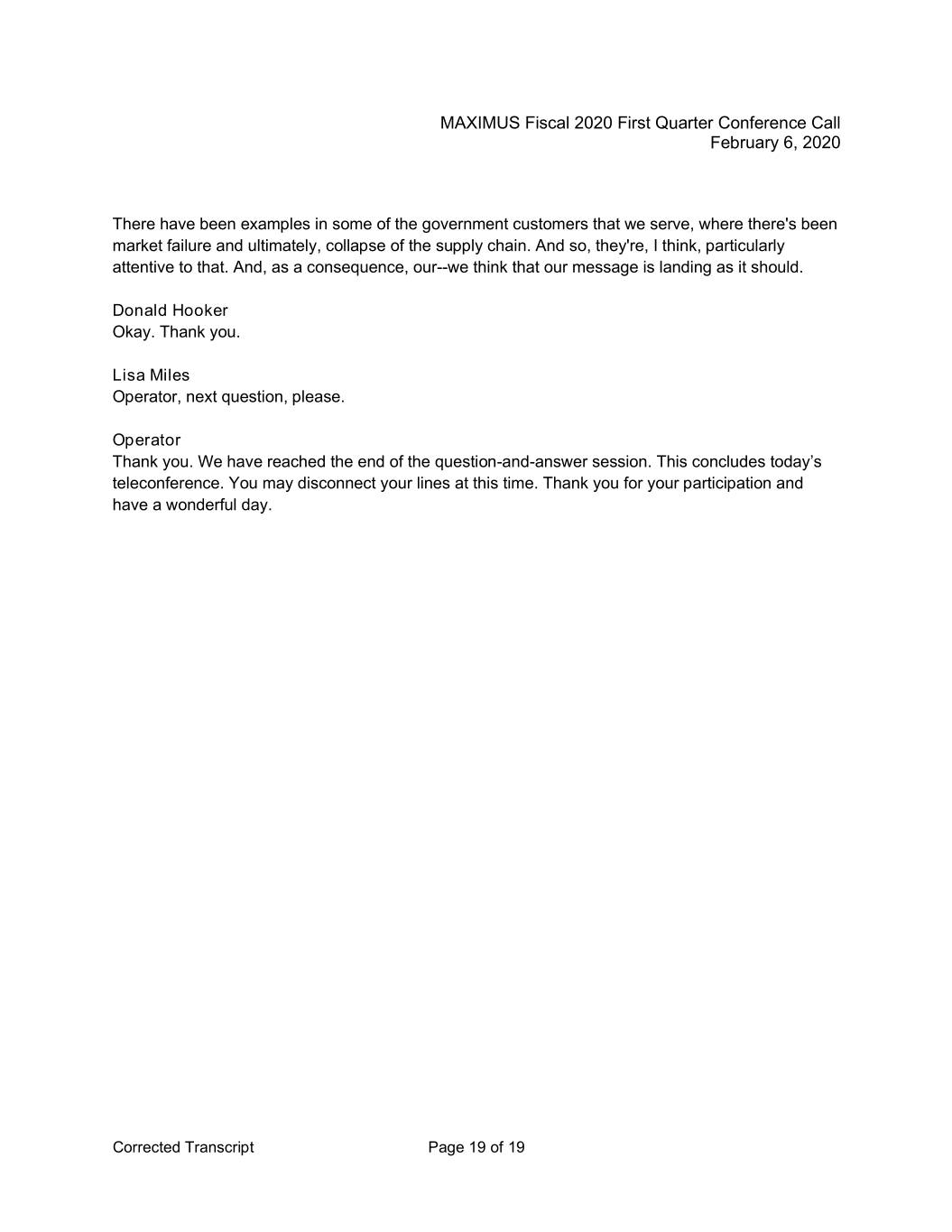
MAXIMUS Fiscal 2020 First Quarter Conference Call February 6, 2020 There have been examples in some of the government customers that we serve, where there's been market failure and ultimately, collapse of the supply chain. And so, they're, I think, particularly attentive to that. And, as a consequence, our--we think that our message is landing as it should. Donald Hooker Okay. Thank you. Lisa Miles Operator, next question, please. Operator Thank you. We have reached the end of the question-and-answer session. This concludes today’s teleconference. You may disconnect your lines at this time. Thank you for your participation and have a wonderful day. Corrected Transcript Page 19 of 19